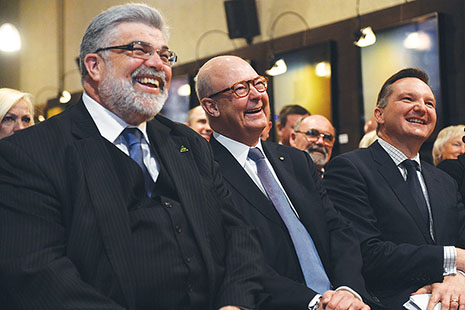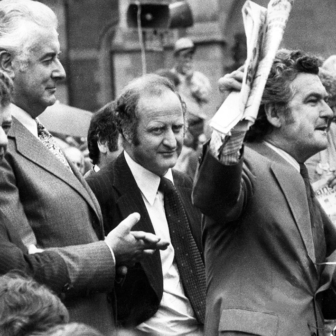Hearts & Minds: A Blueprint for Modern Labor
By Chris Bowen | Melbourne University Press | $24.99
A Letter to Generation Next: Why Labor
By Kim Carr | Melbourne University Press | $24.99
Downfall: How the Labor Party Ripped Itself Apart
By Aaron Patrick | ABC Books | $29.99
The Socialist Way: Social Democracy in Contemporary Britain
Edited by Roy Hattersley and Kevin Hickson | I.B. Tauris | $44
THE belief that we are in the final weeks of a federal Labor government seemed a little less certain after the latest round of musical chairs saw Kevin Rudd replace Julia Gillard as prime minister. Suddenly, books about the Labor Party with titles like Aaron Patrick’s Downfall: How the Labor Party Ripped Itself Apart appeared less marketable. Chris Bowen and Kim Carr, who had both written short books about the party during a fallow period following their resignations from the Gillard ministry, were once again busy with the plough: Bowen at Treasury, and Carr back in his old job in Innovation, Industry, Science and Research. The ink in Bowen’s book was barely dry when the resurrected Rudd took up the proposal that leaders of the federal Labor Party would be elected by a vote of ordinary party members as well as caucus, each with a 50 per cent share in the outcome.
In reality, Labor’s crisis hadn’t gone away just because Rudd was travelling better than Gillard had in the polls. But neither Bowen nor Carr was likely to see party reform as quite so urgent now that each was back helping to run the farm. Indeed, on the very day that the NSW Independent Commission Against Corruption’s adverse findings against former state politicians Eddie Obeid and Ian Macdonald were all over the media, Carr told an audience at the Australian National University that what really mattered was who led the party, not its structures and rules. This was perhaps a reasonable attitude to take a few days after a change of leadership has propelled you back into a much-loved ministerial portfolio, but Carr’s views were otherwise utter nonsense. As Patrick’s book shows only too well, his claim might be challenged by Nathan Rees, the former premier of New South Wales, who became “former” after managing to get a rule change that allowed him to eject from his cabinet some of the least savoury characters he had inherited from his predecessors.
Carr, of course, is an old Victorian factional warrior himself, and it would be surprising in the circumstances if he were to recommend root-and-branch changes to the Labor Party. And he doesn’t. In his discussion of the party’s relationship with the unions, Carr preaches about the importance of embracing change without making a single specific proposal about how the relationship might be reformed. This at a time when Labor-affiliated unions represent perhaps 10 per cent of the workforce while their officials control 50 per cent of the votes at conference, effectively “owning” the party apparatus lock, stock and barrel. And Bowen’s book is hardly any better on this point; he, too, is a beneficiary of an unreformed Labor Party.
Patrick’s book shows vividly how Labor seats are treated as union property. As a result, the disgraceful behaviour of Health Services Union officials is a matter not simply for the union, its long-suffering members and law enforcement officials, but also for the Labor Party itself. Whatever Craig Thomson — or the wily enemies he accuses of having framed him — did with his union’s credit cards became a matter capable of destabilising a minority Labor government. Michael Williamson is not only the discredited former HSU boss but also a former Labor Party president — and presumably a discredited one on account of his behaviour in the union. Julia Gillard’s legal work for the Australian Workers’ Union almost a generation ago — and her personal relationship with a dodgy AWU official — came back to bite the government she led and, in the minds of some observers, dovetailed all too neatly with more recent stories of union corruption.
Patrick describes how these scandals unfolded and successfully evokes the culture that produced them. He doesn’t analyse the underlying structures that allow union leaders and factional bosses to wield power like feudal barons, and nor does he much puzzle over what makes his characters tick; we are usually left to draw our own conclusions on the basis of the behaviour he describes. Some, such as Bill Shorten — who Patrick seems to regard, for all his faults, as a key to Labor’s future — clearly love power, and the game of politics. Perhaps they also love doing good, but Patrick has less to say about this side of Labor politics than about the colourful clash of personalities and the less worthy impulses.
The desire for personal profit would appear a significant motivation for many of the players. On this subject, there is no need for me to recapitulate here ICAC’s findings on Eddie Obeid and Ian Macdonald, but Patrick tells the story of that scandal well and traces its damage to the ailing Labor governments of New South Wales and Australia. Family values are also clearly alive and well in the modern labour movement; Kathy Jackson — on $286,976 a year as an HSU official — arranged for the union to hire the two teenage sons of her partner, Michael Lawler, who was a deputy president of Fair Work Australia, the body charged with the duty of investigating the union. Williamson, of the same union, ran what amounted to a highly lucrative family employment-creation scheme.
In general, the culture Patrick describes would be incomprehensible without an understanding of who shares a bed with whom in the Australian labour movement. And I am not writing metaphorically here. The modern labour movement — as depicted in this book — has more than a passing resemblance to a scandalous medieval court.
WHERE does all of this leave Bowen and Carr? Bowen is from the NSW Labor right. “Some people turn on the TV and see Eddie Obeid as the personification of the NSW right,” he says. “I see Young Labor activists with a passion for moderate but vital reforms. I see people of the passion and talent of NSW general secretary Sam Dastyari… I see very hardworking MPs who instinctively understand the aspirations of the areas they represent.” But one of the party’s problems is that key figures on the NSW right saw quite a lot of Obeid well before the rest of us and apparently did nothing about him, just as most left-wingers failed to do anything much to stop Macdonald before he did immense harm to himself and his party.
Both Bowen and Carr seek to navigate a course for the Labor Party. Bowen, by far the younger of the two men, is much more likely to be a central player in that future. Unfortunately, there is very little in his book to warrant any enthusiasm about this prospect. When he is not telling us what a beaut job he did of reforming superannuation, he is trying to persuade us that Labor is a truer “liberal” party than the Liberal Party, a rhetorical device which is as old as the Labor Party itself. In fact, much of what Bowen proposes — including his tedious calls for “growth” — could well have come from a real member of the Liberal Party. Like Tony Abbott, he reckons Labor must govern alone or not at all, and especially not with those dastardly “anti-growth” Greens — a position that would not survive for thirty seconds if Labor once again needed to do a deal so that the likes of Bowen could keep their backsides on the government benches.
His guiding philosophy is, in fact, neo-liberalism, with a bit of state intervention thrown in here and there to assist individuals on their way up what Mark Latham called “the ladder of opportunity.” Like several other ambitious NSW right-wingers past and present, Bowen nurtures the neo-Blairite ambition of ditching the party’s socialist objective in favour of something more modern and relevant. He even wants the Labor Party to debate this pressing matter; God knows who he thinks will want to debate it with him. And when the likes of Bowen propose their alternative to the socialisation objective, as they cannot forbear from doing, they come up with ideas so dull and prose so banal that it produces a nostalgia for Marx and Engels even in the least socialistically inclined reader. Bowen’s “vision” for Labor is what you get when a party of the centre-left abandons a moral critique of capitalism as well as any sense that it has a role in promoting social solidarity. All that’s left for Labor to do is to provide the conditions under which individuals can do well out of the system.
One has good reason for expecting better of Carr. Where Bowen belongs to a conservative Sydney Labor tradition, Carr is a Melbourne man, and in many ways a product of that city’s optimistic left tradition: more keen on state intervention; more inclined to celebrate collectivism; and more interested in the finer points of ideological distinction, although the grown-up politician has mainly put away childish things of this kind. But he at least recognises that a Labor commitment needs to be about the heart rather than the head. Bowen’s book is called Hearts & Minds, but it seems to have little prospect of appealing to either; his subtitle, which includes the term “blueprint,” is a clearer indication of what’s in store for readers. Carr frames his account — albeit very loosely — as a letter to a younger generation possibly cynical about formal parliamentary politics and the Labor Party, explaining why they should support the party or even join it. There is more “heart” in Carr’s account than in Bowen’s, and an infectious enthusiasm about manufacturing and science, the latter broadly defined to include the humanities, social sciences and creative arts. Carr sees the possibilities for Australia offered by high achievement in these fields, and is an eloquent defender in print, as he has been in office, of government support for car manufacturing.
No less than Bowen, he believes in growth and markets and seems to despise the Greens. But he has a more expansive sense of what governments can and should do, arguing that intervention by a strong state is needed in order to make capitalism work in the interests of society — or, in the context of continuing global financial instability, perhaps work at all. In this emphasis, and in Carr’s insistence on a rich “communal life” as an end in itself, we do gain the flavour of something more distinctively “Labor” than Bowen is capable of evoking. There is plenty of exaggeration in Carr’s book — is the public really being “constantly told that its hard-earned taxes are being squandered on the poor”? — but all in the cause of motivating his readers to change the world by getting involved in the Labor Party.
MOVING from these recent Australian Labor contributions to former British Labour Party deputy leader Roy Hattersley and politics academic Kevin Hickson’s collection The Socialist Way is a bit like stepping up from a plasticine session in kindergarten to a doctoral seminar. If this sounds like a case of the cultural cringe, I’m perfectly happy to be considered a cringer. The collection brings together an impressive cast of academics and past and present Labour politicians, and they often say things about modern social democracy that the Australian debates about the future of the Labor Party don’t approach in sophistication or richness.
This probably has something to do with the much stronger culture of left-leaning think tanks in Britain, a bigger university sector with many more scholars working at the junction of political theory and party politics, and a range of quality newspapers and magazines which still manage to rise above a lowest common denominator. It’s not just that the Labour left in Britain is still prepared to talk about socialism and equality and seem like they mean it. Many of these authors are asking more fundamental questions about the direction of Labour thinking than are found anywhere in the ALP. There is a clear movement away from a politics of redistribution towards a reappraisal of political economy itself — a reaction, no doubt, to the mess the banks have made of the country as well as declining public support for aspects of the welfare state.
As with Carr in Australia, there is also a commitment to a British future in which people actually make things (other than financial products). The contributors to The Socialist Way, moreover, relate their ideas to Britain’s progressive tradition. In Australian debate, you could sometimes be forgiven for thinking that Labor achieved nothing of note before the Whitlam government came to power. Meanwhile, the growing obsession with the glorious Hawke government is doing more harm than good to a party that needs to grapple with quite different policy, philosophical and electoral problems from those it faced in the 1980s.
There are other reasons why Australian debate about the future of Labor is so impoverished. In Britain, there must be very few cities of any size whose high street does not bring home to even a casual observer the depth of inequality and deprivation. These problems, moreover, have worsened since the global financial crisis, and even more so since the Cameron–Clegg outfit began its deep cuts in spending. Australia has had a much easier run, although you certainly wouldn’t know it from the whining that is now such a salient feature of our political discourse.
More desperate circumstances in Britain have generated more adventurous ideas. Proponents of Blue Labour, which I have previously discussed in Inside Story, and Purple Labour, a tendency associated with Blairism, are hostile to statist and centralist solutions to Britain’s manifold economic and social problems. Their insistence on localism and voluntarism has inevitably provoked a forthright defence, as in this collection, of a more traditional social democracy that relies to a large extent on strong action by a reformed central state.
But there is also plenty of common ground among the different schools of thought in the British Labour Party, whatever their colour. Most would in practice support the “measured statism” that Andrew Vincent presents in his contribution to the collection as characteristic of social democracy. Several of the authors evidently accept that the centralisation characteristic of social policy in the Blair years was often counterproductive, an opinion associated with both Blue and Purple Labour. And there is a celebration of a Labour patriotism by John Denham, a member of the House of Commons, with which Maurice Glasman of Blue Labour would be unlikely to quarrel. Following a speech by Labour leader Ed Miliband in 2012, the party now packages many of its policy ideas with the label “One Nation Labour,” a term unlikely to catch on in Australia (although it was used by Paul Keating before Pauline Hanson).
Kim Carr’s book is closest in spirit and substance to much of this British social-democratic discussion. All the same, there is an optimism at the heart of his vision that is much harder for his British counterparts to capture. It is not just that they are out of government while he — at least for the time being — remains in harness. There is also a less-qualified faith among Australian thinkers in the power of the state to do good, and much less interest in local and voluntary solutions associated with cooperatives and mutuals. But the political scene that politicians like Carr and Bowen, and the rest of us, encounter after 7 September may well stimulate harder thinking and greater creativity than found so far in the lengthening procession of books on the Australian Labor Party. •




